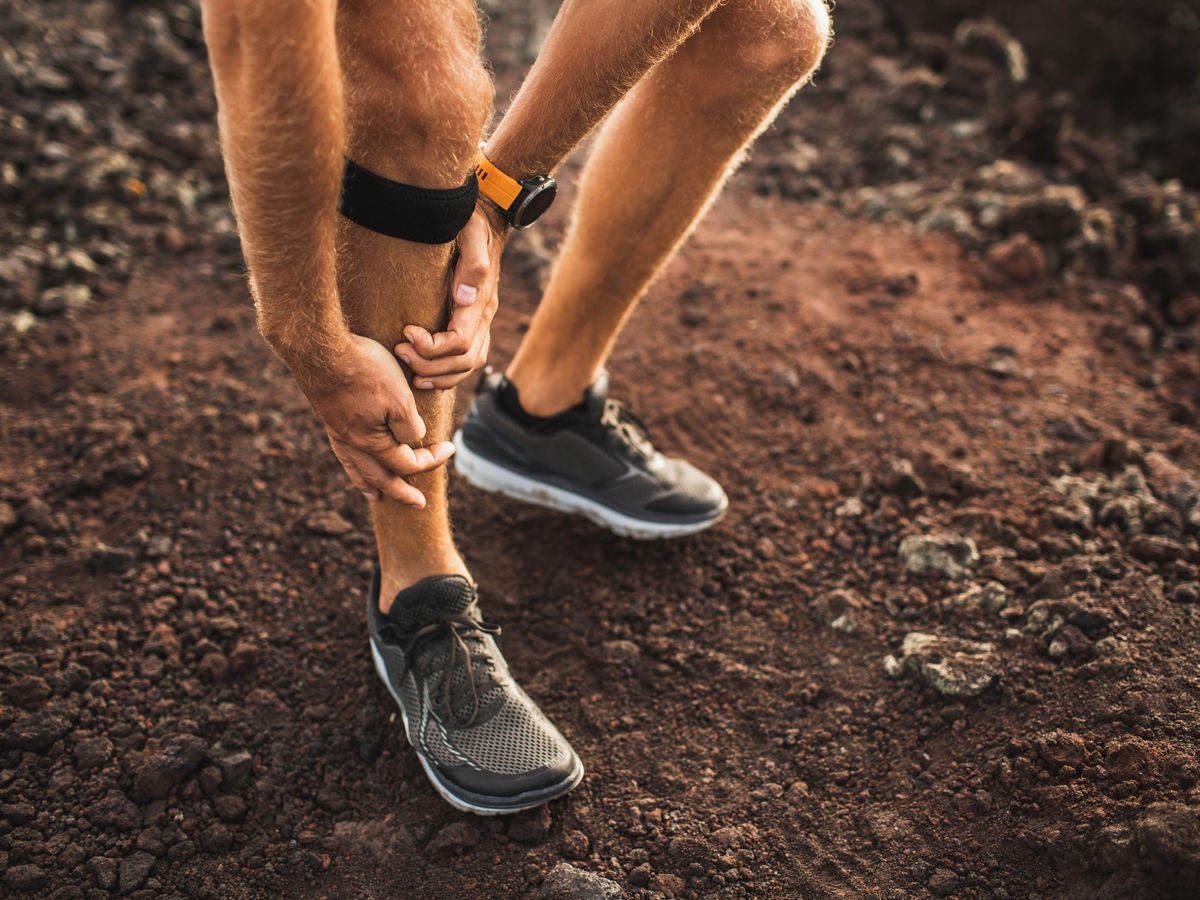Home>Misc>Featured>How To Run On Beach Without Getting Sand In Running Shoes


Featured
How To Run On Beach Without Getting Sand In Running Shoes
Modified: August 22, 2023
Learn how to run on the beach without getting sand in your running shoes. Get tips and tricks for a sand-free workout. Featured.
Introduction
Running on the beach can be an exhilarating and refreshing experience. The sound of crashing waves, the feel of warm sand beneath your feet, and the stunning coastal views all contribute to making beach running a favorite activity for many fitness enthusiasts. However, one common challenge that runners face when hitting the sandy shores is getting sand trapped in their running shoes.
Dealing with sand in your shoes can be uncomfortable and inconvenient, but fear not! In this article, we will explore some helpful tips and tricks to help you run on the beach without getting sand in your running shoes.
Choosing the right footwear is crucial when it comes to beach running. Regular running shoes may not be the best option as they tend to collect sand, making each step feel heavy and uncomfortable. Instead, opt for lightweight and breathable shoes that have a closed mesh design to prevent sand from entering.
Once you have chosen the right shoes, it’s important to prepare them before hitting the beach. Start by removing the insoles and giving them a good shake to get rid of any residual sand or debris. You can also sprinkle some baby powder or talcum powder inside the shoes to minimize friction and prevent sand from sticking to the fabric.
Another factor to consider is the running surface. Not all parts of the beach are ideal for running, as some areas can have deep or loose sand that makes it difficult to maintain your pace. Look for firmer, packed sand close to the waterline or consider running on the wet sand for more stable footing.
Having a proper running technique can also help prevent sand from getting into your shoes. Lift your feet slightly higher than you would on pavement to avoid dragging them through the sand. This will reduce the chances of sand particles finding their way into your shoes.
While prevention is key, there are additional tips you can follow to keep sand out of your shoes during your beach run. Avoid running close to the water where the wet sand can be more prone to sticking to your shoes. Additionally, try to run in a straight line rather than making sharp turns, as this can kick up more sand and increase the likelihood of it getting inside your shoes.
After your beach run, it’s essential to take care of your shoes to prevent any long-term damage. Remove the insoles again and shake out any sand that may have found its way inside. You can also rinse the shoes with fresh water to remove any remaining sand and salt.
By following these tips, you can confidently enjoy your beach runs without the discomfort of sand in your shoes. So, lace up, head to the beach, and experience the joy of running along the beautiful coastline!
Choosing the Right Footwear
When it comes to beach running, selecting the right footwear is paramount. Your regular running shoes, while suitable for pavement and trails, may not be the best choice for sandy terrain. The soft sand can easily make its way into your shoes, causing discomfort and affecting your performance. That’s why it’s important to choose a pair of shoes specifically designed for beach running.
First and foremost, opt for lightweight shoes. Heavy shoes can sink into the sand and make each step feel like a struggle. Look for shoes that are specifically designed for running on soft surfaces such as sand, as they are typically lighter and more flexible.
One key feature to consider is a closed mesh design. This design prevents sand from entering your shoes while still allowing for ample airflow to keep your feet cool and dry. This is particularly important as the combination of sand and moisture can lead to friction and discomfort.
Another important factor to consider is the shoe’s outsole. Look for shoes with an outsole that provides good traction on sandy surfaces. It should have deep and wide treads to help you maintain stability and grip, even on loose sand.
In addition to the shoe’s design, the fit is crucial to ensure comfort and prevent sand from sneaking inside. Make sure to try on different sizes and consider opting for a slightly snug fit to prevent excessive movement of the foot inside the shoe. However, be mindful not to choose a size that is too tight, as this can lead to discomfort and blisters.
Consider shoes with a secure lacing system as well. This helps to keep your feet in place and reduces the chances of sand entering through any gaps. It’s also a good idea to choose shoes with a cushioned and supportive midsole, as this can provide comfort and absorb shock, making your beach runs more enjoyable.
Lastly, make sure to choose shoes made from materials that are water-resistant or quick-drying. This will help prevent your shoes from becoming waterlogged if you encounter any water on your beach run.
Remember, selecting the right footwear is essential for a comfortable and enjoyable beach running experience. By choosing lightweight, closed mesh shoes with good traction and a snug fit, you can minimize the amount of sand that finds its way inside your shoes and focus on getting the most out of your run.
Preparing the Shoes for Running
Before hitting the beach for your run, it’s essential to properly prepare your shoes to minimize the chances of sand getting inside. By taking a few simple steps, you can ensure a more comfortable and enjoyable beach running experience.
Firstly, start by removing the insoles of your shoes. This allows you to shake them out and get rid of any sand or debris that may have accumulated inside. Give them a good shake to ensure that all the sand particles are removed.
Next, take a moment to inspect your shoes. Check for any openings or gaps where sand could easily enter. Pay special attention to the area where the upper meets the sole, as well as the lacing system. If you notice any loose stitching or worn-out areas, consider reinforcing them to prevent sand from finding its way inside.
To further prevent the sand from sticking to your shoes’ fabric, you can apply a thin layer of baby powder or talcum powder inside the shoes. The powder helps to minimize friction and create a barrier that reduces the likelihood of sand particles attaching to the shoe material. Remember to spread the powder evenly across the insole and ensure that it covers all areas.
Additionally, some beach runners find it helpful to wear moisture-wicking socks. These socks are designed to draw moisture away from your feet, keeping them dry and reducing the chances of sand sticking to your skin. Look for socks made from breathable materials such as synthetic blends or merino wool, as they are better at wicking away moisture compared to cotton socks.
It’s important to note that even with proper preparation, some sand may still find its way into your shoes during your run. However, by following these steps, you can significantly minimize the amount of sand that accumulates, making your beach running experience more enjoyable and comfortable.
Remember to repeat these preparations before every beach run to ensure that your shoes are always sand-free and ready to go. By taking the time to properly prepare your shoes, you can focus on achieving your running goals and enjoying the picturesque shoreline without the hassle of sandy discomfort.
Selecting the Ideal Running Surface
When it comes to beach running, not all parts of the beach offer the same running experience. The type of running surface can greatly affect your performance and the amount of sand that gets into your shoes. Therefore, it’s important to select the ideal running surface to make your beach run more enjoyable.
One of the best surfaces for beach running is packed or firm sand. Look for areas closer to the waterline where the sand is more compact. Firm sand provides better traction and stability, allowing you to maintain your running pace with ease. It also minimizes the risk of sinking into the sand, which can make your run more challenging and increase the chances of sand entering your shoes.
Another option is to run on wet sand. The wet sand near the water’s edge is more compact and provides a solid surface for running. It’s important to note that wet sand can still accumulate in your shoes, but it is less likely to do so compared to dry or loose sand.
However, it’s generally advisable to avoid running on areas where the sand is deeper or softer. These areas require more effort to run on as each step sinks into the sand. This can cause your feet to become more exposed to sand particles, increasing the likelihood of it entering your shoes.
It’s also worth considering the timing of your beach run. Running during low tide can provide you with a larger stretch of wet sand, making it easier to find a suitable running surface. Keep in mind that the beach conditions can vary depending on the time of day and tide, so it’s always a good idea to check the tide schedule before heading out for your run.
Lastly, if you have access to a beach that has a designated running or jogging path, take advantage of it. These paths are typically more packed and offer a clear route for runners. Running on a designated path reduces the chances of encountering loose sand and provides a more consistent surface for your run.
When selecting the ideal running surface, choose packed or wet sand over deep or soft sand whenever possible. By being mindful of the beach conditions and paying attention to your surroundings, you can have a more enjoyable and sand-free beach running experience.
Running Technique for the Beach
Running on the beach requires a slightly different technique compared to running on pavement or trails. By adjusting your running technique, you can minimize the impact of sand and reduce the chances of sand entering your shoes.
First and foremost, it’s important to lift your feet slightly higher than you would when running on a harder surface. This helps to prevent your feet from dragging through the sand, reducing the amount of sand that can get trapped inside your shoes. Lifting your feet higher also allows for a smoother and more efficient stride, helping you maintain your pace.
When running on the beach, try to maintain a slightly shorter stride. A shorter stride helps to generate more power and push off from the sand, enabling you to move forward with greater ease. It also helps to prevent your feet from sinking too deeply into the sand, reducing the amount of sand that can enter your shoes.
Another important aspect of running technique for the beach is to relax your feet and ankles. This helps to absorb the unevenness of the sand and reduces the strain on your lower limbs. Keeping your feet and ankles relaxed also allows your toes to flex naturally, which can help to dislodge any sand that may have found its way into your shoes.
When running on the beach, it’s also helpful to engage your core muscles. A strong and stable core will provide better balance and control, allowing you to navigate the sand more efficiently. Focus on maintaining an upright posture and engaging your abdominal muscles to stabilize your body as you run.
Lastly, be mindful of your surroundings and adapt your technique accordingly. Keep an eye out for any obstacles such as rocks or debris on the beach, and adjust your stride or foot placement to avoid them. Remember to listen to your body and adjust your pace or intensity as needed to prevent overexertion.
By following these running techniques for the beach, you can have a more enjoyable and efficient run while minimizing the discomfort of sand in your shoes. Remember to practice and experiment with different techniques to find what works best for you. Enjoy the unique experience of beach running and savor the beauty of the coastal scenery!
Tips for Avoiding Sand in Running Shoes
While running on the beach can be a delightful experience, dealing with sand in your shoes can be quite bothersome. Here are some practical tips to help you avoid sand from getting trapped in your running shoes:
- Choose the right shoes: Opt for lightweight and breathable shoes with a closed mesh design. This will help prevent sand from entering your shoes while still allowing for proper airflow.
- Remove insoles and shake: Before heading out for your run, take out the insoles and give them a good shake to remove any residual sand or debris. This will create a clean space inside your shoes.
- Apply powder: Sprinkle some baby powder or talcum powder inside your shoes to reduce friction and create a protective barrier. This can help prevent sand particles from sticking to the shoes’ fabric.
- Choose the right running surface: Opt for packed or wet sand closer to the waterline as it offers better stability and reduces the chances of sinking into the sand. Avoid areas with deep or loose sand where it’s easier for sand to enter your shoes.
- Adjust your running stride: Lift your feet slightly higher than usual to avoid dragging them through the sand. A shorter stride can also help you generate more power and minimize sinking into the sand.
- Run in a straight line: Avoid making sharp turns which can kick up more sand and increase the chances of it entering your shoes. Stay on a straight path to minimize sand disturbance.
- Run farther from the water: While it may be tempting to run close to the water’s edge, the wet sand can be more prone to sticking to your shoes. Stay a bit farther away to minimize the amount of wet sand you encounter.
- Properly care for your shoes after the run: Once you’ve finished your beach run, remove the insoles again and shake out any sand that may have made its way inside. If possible, rinse your shoes with fresh water to remove any remaining sand and salt.
By following these tips, you can greatly reduce the annoyance of having sand invade your running shoes. Remember to experiment and find the techniques that work best for you. Now, lace up your shoes, hit the beach, and enjoy your sand-free running adventure!
After-Run Shoe Care
Caring for your running shoes after a beach run is crucial to maintain their performance and longevity. By following a few simple steps, you can keep your shoes in good condition and prevent any long-term damage caused by sand and saltwater.
First, remove the insoles from your shoes and give them a thorough shake to remove any sand or debris that may have accumulated during your run. This step is essential to prevent sand from grinding against the shoe’s materials, which can cause unnecessary wear and tear.
Next, rinse your shoes with fresh water to remove any remaining sand and salt. Use a gentle stream of water and a soft brush to clean both the upper and the outsole of the shoes. Avoid using harsh chemicals or excessive scrubbing, as this can damage the materials of the shoe.
Once your shoes are rinsed, use a clean towel to gently pat them dry. Avoid wringing or twisting the shoes, as this can alter their shape. It’s important to allow your shoes to air dry fully before storing them to prevent the growth of bacteria or unpleasant odors.
After your shoes are completely dry, inspect them for any signs of damage or wear. Check for loose threads, peeling soles, or any other issues that may need attention. Addressing these issues promptly can help extend the lifespan of your shoes and prevent further damage.
If your shoes have an odor after several uses, there are a few remedies you can try. Sprinkling a small amount of baking soda inside the shoes can help absorb moisture and eliminate odor. You can also use odor-eliminating sprays specifically designed for shoes.
When storing your shoes, keep them in a cool and dry place away from direct sunlight. Avoid leaving them in a closed or humid environment, as this can promote the growth of mildew or mold.
Lastly, it’s important to periodically replace your running shoes to ensure optimal performance and support. Running shoes typically have a lifespan of around 300-500 miles, depending on various factors such as your running style and weight.
By practicing proper after-run shoe care, you can extend the lifespan of your running shoes and keep them in top condition. Regular maintenance is essential for maximizing performance and ensuring your feet stay comfortable and protected during your next beach run.
Conclusion
Running on the beach provides a unique and invigorating experience, but dealing with sand in your running shoes can be a frustrating challenge. By following the tips and techniques discussed in this article, you can minimize the discomfort and inconvenience of sand invading your shoes during your beach runs.
Choosing the right footwear, preparing your shoes before each run, selecting the ideal running surface, and adjusting your running technique are all key factors in preventing sand from entering your shoes. Additionally, following proper after-run shoe care practices will help maintain the longevity and performance of your running shoes.
Remember to select lightweight and breathable shoes designed for beach running, remove the insoles and apply powder before your run, and choose packed or wet sand as your running surface. Lift your feet slightly higher, run in a straight line, and engage your core muscles to optimize your running technique on the beach.
After your run, take the time to remove any sand from your shoes, rinse them with fresh water, and allow them to dry completely before storing them in a cool and dry place. Regularly inspect your shoes for any signs of damage and consider replacing them when needed to ensure optimal performance.
By incorporating these tips into your beach running routine, you can enjoy the beauty of the shoreline and the exhilaration of running without the annoyance and discomfort of sand in your shoes. So, lace up your running shoes, hit the beach, and embrace the joy of running along the sandy shores!









